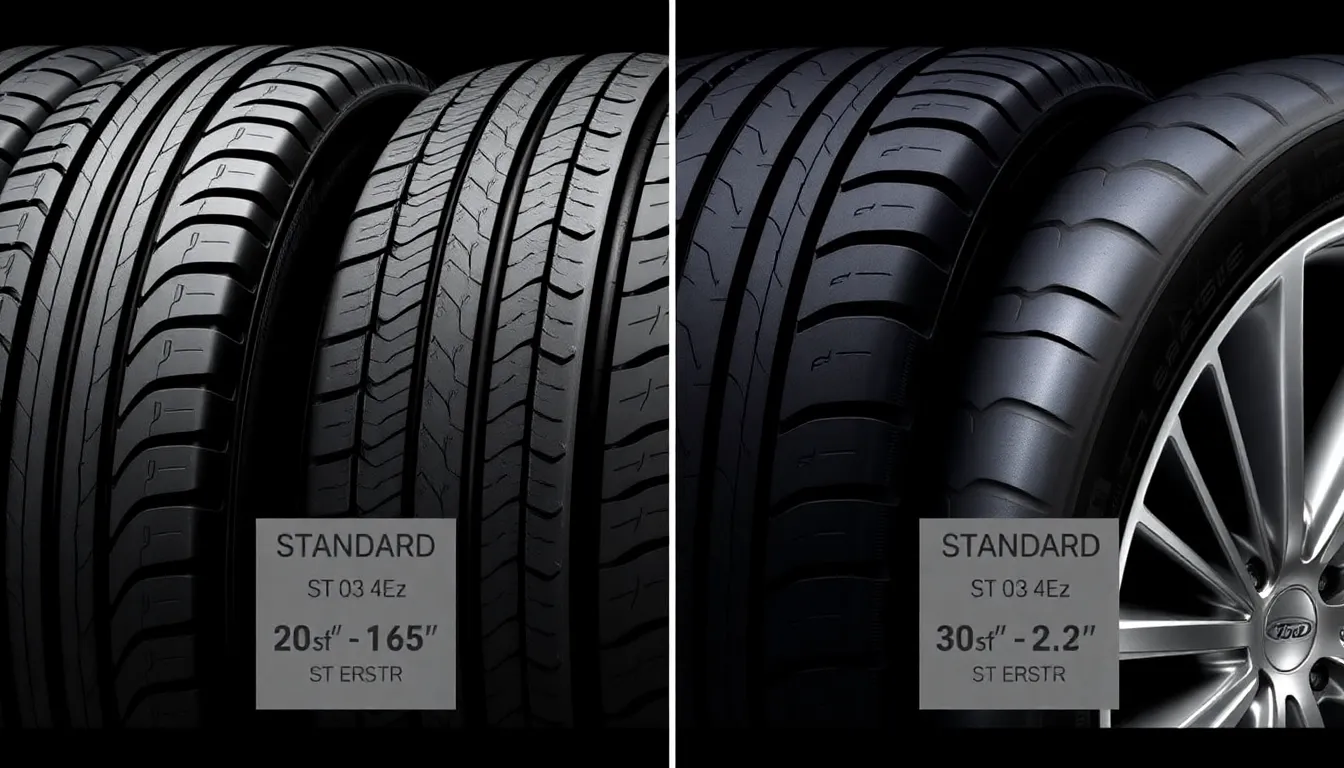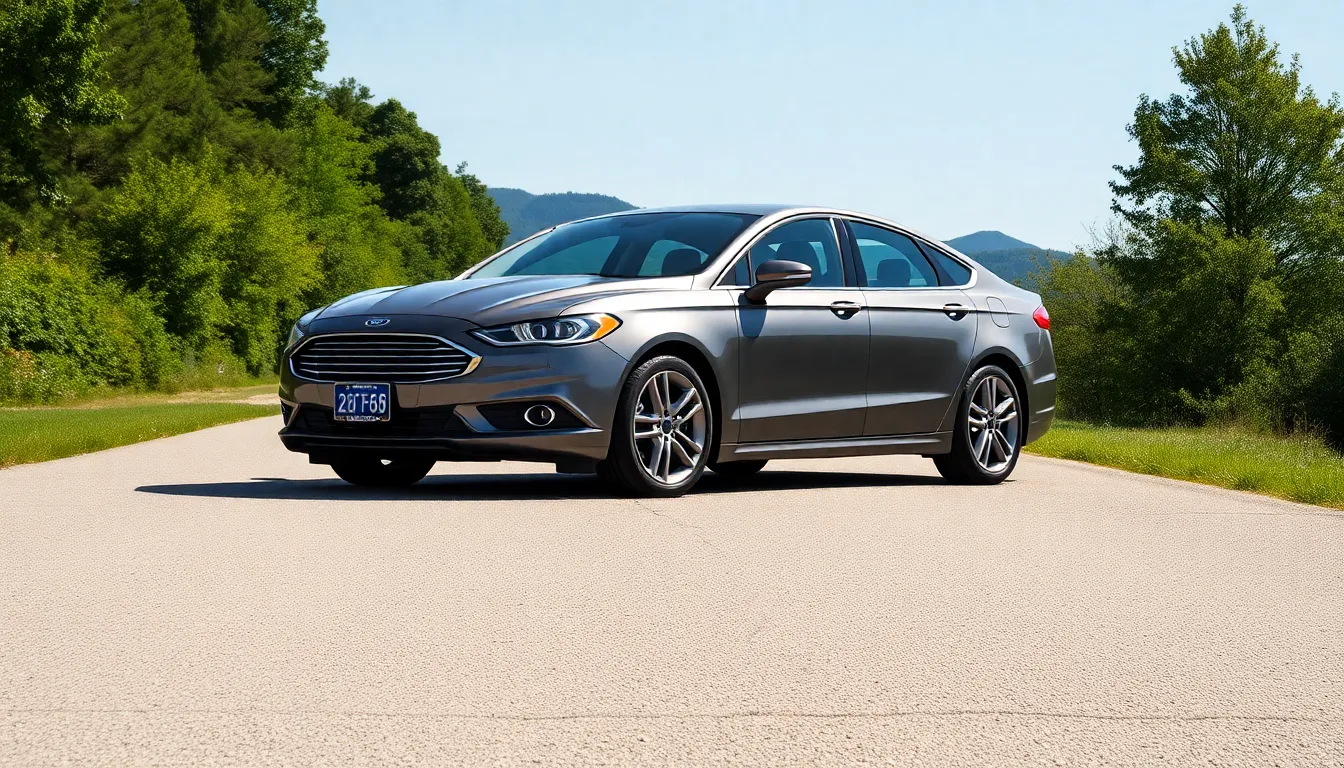Finding the right tire size for your 2016 Ford Fusion can make all the difference in your driving experience. Whether you’re looking to replace worn tires or upgrade for better performance we’ll help you navigate the various options available for this popular sedan.
Your 2016 Fusion came with different tire sizes depending on the trim level and package you chose. From the standard S model to the sport-tuned Titanium each variant has exact tire requirements that affect everything from fuel economy to handling characteristics.
We’ve compiled everything you need to know about 2016 Ford Fusion tire sizes including OEM specifications aftermarket options and how different sizes impact your vehicle’s performance. Let’s jump into the details that’ll help you make the best tire choice for your exact needs and driving style.
Understanding 2016 Ford Fusion Tire Specifications
Understanding the tire specifications for your 2016 Ford Fusion ensures optimal performance and safety. These specifications vary significantly across different trim levels and directly impact your vehicle’s handling characteristics.
Factory Tire Sizes by Trim Level
The 2016 Ford Fusion comes equipped with different tire sizes depending on the exact trim level you own. Base S and SE models typically feature 225/60R16 tires that provide excellent fuel economy and comfortable ride quality. Titanium trim levels use 235/50R18 tires for enhanced handling and a more aggressive appearance. Sport models receive 245/45R19 performance tires designed for superior cornering capabilities and road responsiveness.
| Trim Level | Standard Tire Size | Wheel Diameter | Performance Focus |
|---|---|---|---|
| S | 225/60R16 | 16 inches | Fuel Economy |
| SE | 225/60R16 | 16 inches | Comfort |
| Titanium | 235/50R18 | 18 inches | Balance |
| Sport | 245/45R19 | 19 inches | Performance |
Hybrid variants of the Fusion exclusively use 225/50R17 tires that optimize rolling resistance for maximum fuel efficiency. These specifications directly affect your vehicle’s speedometer accuracy, ground clearance, and overall performance characteristics.
Reading Tire Size Numbers and Letters
Tire size markings follow a standardized format that conveys essential information about dimensions and capabilities. The first number (225) represents the tire width in millimeters measured from sidewall to sidewall. Following the slash, the second number (60) indicates the aspect ratio as a percentage of the tire’s width to its sidewall height.
The letter R stands for radial construction, which describes how the tire’s internal layers are arranged. Next comes the wheel diameter in inches (16), which must match your rim size exactly. Additional markings include the load index number that specifies maximum weight capacity and speed rating letters that indicate safe operating speeds.
Load indexes typically range from 91 to 98 for 2016 Fusion applications, with higher numbers supporting greater weight loads. Speed ratings use letters such as H (130 mph), V (149 mph), or W (168 mph) to designate maximum safe speeds. These specifications ensure proper fitment and safe operation within your vehicle’s designed parameters.
OEM Tire Options for 2016 Ford Fusion

Ford designed the 2016 Fusion with exact tire configurations across different trim levels to optimize performance characteristics. We’ve compiled the exact OEM specifications to help you understand what came factory-installed on your vehicle.
Standard Tire Sizes
The Fusion S trim features 215/60R16 tires as its standard configuration. SE models come equipped with 235/50R17 tires that provide enhanced handling over the base trim.
Hybrid and Energi variants use 225/50R17 tires designed for optimal fuel efficiency. These eco-focused models prioritize lower rolling resistance to maximize electric range and overall fuel economy.
| Trim Level | Standard Tire Size |
|---|---|
| Fusion S | 215/60R16 |
| Fusion SE | 235/50R17 |
| Fusion Hybrid | 225/50R17 |
| Fusion Energi | 225/50R17 |
Performance and Sport Package Options
Sport package configurations include larger wheel and tire combinations for enhanced road performance. Sportier models feature 235/45R18 tires that deliver improved cornering capabilities and visual appeal.
Premium sport configurations use 235/40R19 tires mounted on 19-inch wheels. These low-profile options provide maximum handling precision and aggressive styling for performance-oriented drivers.
The spare tire specification across all 2016 Fusion models measures 125/80R18 for temporary use. Always verify your exact tire size using the placard located on the driver’s side doorjamb for precise fitment requirements.
Best Tire Brands for 2016 Ford Fusion

Selecting quality tire brands for your 2016 Ford Fusion ensures optimal performance across different driving conditions. Top tire manufacturers offer specialized options that match the Fusion’s diverse trim requirements and driving scenarios.
All-Season Tire Recommendations
All-season tires provide year-round versatility for most 2016 Fusion drivers. Michelin Premier LTX delivers exceptional wet weather performance and long tread life across all Fusion trim sizes. Continental AllSeasonContact LS offers superior comfort and quiet operation for daily commuting. Goodyear Assurance All-Season provides reliable traction and fuel efficiency optimization for S and SE trim levels.
These manufacturers design their all-season options to balance performance characteristics including wet grip, dry handling, and tread longevity. Michelin’s Premier LTX features EverGrip technology that maintains traction as the tire wears. Continental’s AllSeasonContact LS incorporates PremiumPlus Technology for enhanced comfort and reduced road noise.
Performance Tire Options
Performance focused drivers benefit from specialized tire technologies designed for enhanced handling. Michelin Pilot Sport A/S 3 combines sport performance with all-season capability for Titanium and Sport trim levels. Continental ExtremeContact Sport delivers maximum dry grip and responsive steering for aggressive driving styles. Goodyear Eagle F1 Asymmetric 3 provides superior cornering stability and high-speed performance.
Performance tires feature advanced compound formulations and tread patterns that optimize contact patch distribution. Michelin’s Pilot Sport series utilizes Variable Contact Patch 3.0 technology for consistent performance. Continental’s ExtremeContact Sport incorporates SportPlus Technology for enhanced dry and wet performance characteristics.
Winter Tire Considerations
Cold weather driving demands specialized tire compounds and tread designs for optimal safety. Michelin X-Ice Xi3 provides exceptional ice and snow traction for harsh winter conditions. Continental WinterContact SI offers reliable winter performance with comfortable ride quality. Goodyear Ultra Grip Winter delivers dependable snow traction and winter weather handling.
Winter tires maintain flexibility in temperatures below 45°F when all-season compounds become rigid. Michelin’s X-Ice Xi3 features Cross Z Sipes technology for enhanced ice grip performance. Continental’s WinterContact SI incorporates Advanced Traction Compound for improved cold weather traction across all 2016 Fusion tire sizes.
Tire Size Impact on Performance and Fuel Economy

Tire size directly influences both handling characteristics and fuel efficiency in the 2016 Ford Fusion. Different tire dimensions create varying contact patches with the road surface, affecting everything from cornering ability to gas mileage.
How Tire Size Affects Handling
Larger tires like the 235/45R18 found on some hybrid models create enhanced handling through increased contact patch area. This wider surface provides superior grip during cornering and improves overall stability at highway speeds. The lower sidewall profile in these larger tires reduces sidewall flex, resulting in more precise steering response and better feedback to the driver.
Smaller tires such as the 215/60R16 on S trim models offer different handling characteristics focused on comfort over performance. These tires feature taller sidewalls that absorb road imperfections more effectively, creating a smoother ride quality. The trade-off comes in reduced cornering precision and slightly less responsive steering feel compared to larger tire options.
Mid-size options like the 235/50R17 on SE models and 225/50R17 on Energi and Hybrid variants balance handling and comfort effectively. These dimensions provide adequate grip for spirited driving while maintaining reasonable ride quality for daily commuting.
Fuel Efficiency Considerations
Tire size creates measurable differences in fuel economy through rolling resistance variations. The 215/60R16 tires on base S models typically deliver the best fuel efficiency due to their narrower width and optimized compound formulation for low rolling resistance.
Larger tires such as the 235/45R18 options increase fuel consumption through higher rolling resistance and additional weight. The wider contact patch that improves handling simultaneously creates more friction with the road surface, requiring additional engine power to maintain speed.
| Tire Size | Rolling Resistance Impact | Fuel Economy Effect |
|---|---|---|
| 215/60R16 | Lowest | Best efficiency |
| 225/50R17 | Moderate | Good efficiency |
| 235/50R17 | Higher | Reduced efficiency |
| 235/45R18 | Highest | Lowest efficiency |
Hybrid and Energi models use 225/50R17 tires specifically chosen to optimize the balance between handling capability and fuel efficiency. These dimensions support the hybrid powertrain’s efficiency goals while providing adequate performance for safe vehicle operation.
Upgrading or Changing Tire Sizes

Modifying tire sizes on your 2016 Ford Fusion requires careful consideration to maintain optimal performance and safety. Understanding proper sizing techniques and potential complications helps you make informed decisions about tire upgrades.
Plus Sizing Guidelines
Plus sizing increases wheel diameter while maintaining similar overall tire diameter to preserve speedometer accuracy and vehicle handling characteristics. Moving from the base 16-inch wheels to 17-inch or 18-inch options creates a popular upgrade path for Fusion owners. The tire sidewall height decreases proportionally to compensate for the larger wheel diameter.
Converting from 215/60R16 to 225/50R17 maintains approximately the same overall diameter while providing improved handling response. Stepping up to 235/45R18 further enhances cornering capabilities through reduced sidewall flex. The firmer sidewalls deliver more precise steering feedback but create a stiffer ride quality.
We recommend maintaining the original overall diameter within 2-3% to avoid mechanical complications. Calculating the new diameter using the formula (wheel diameter + 2 × sidewall height) ensures compatibility with your vehicle’s systems. Professional tire shops can verify calculations and recommend appropriate combinations for your exact driving needs.
Potential Issues with Non-Standard Sizes
Deviating from manufacturer tire size recommendations creates several mechanical and performance complications. Speedometer and odometer readings become inaccurate when overall tire diameter changes significantly from factory specifications. The vehicle’s computer systems calibrate based on original tire dimensions.
| Issue | Impact | Severity |
|---|---|---|
| Speedometer accuracy | 3-5% variance per inch diameter change | Moderate |
| Suspension wear | Increased stress on components | High |
| Fuel efficiency | 2-4% reduction with larger tires | Moderate |
| Wheel well clearance | Potential rubbing during turns | High |
| ABS/Traction control | System calibration errors | Critical |
Oversized tires may contact wheel wells during full steering lock or suspension compression. This rubbing damages both tires and vehicle components while creating safety hazards. Suspension components experience increased stress from altered leverage points and unsprung weight changes.
Electronic stability systems rely on precise wheel speed calculations that become compromised with incorrect tire sizes. Anti-lock braking and traction control systems may activate inappropriately or fail to engage when needed. These safety system malfunctions pose important risks during emergency maneuvers or adverse weather conditions.
Cost Considerations and Where to Buy

Understanding tire costs and purchasing options helps you make informed decisions for your 2016 Ford Fusion replacement tires. Budget planning becomes crucial when selecting the right tires for your exact trim level and driving needs.
Price Ranges for Different Tire Types
All-season tires represent the most economical choice for Ford Fusion owners, typically ranging from $80 to $150 per tire. These versatile options work well for daily commuting and general driving conditions throughout most of the year.
Performance tires command higher prices between $120 to $200 per tire due to their advanced rubber compounds and enhanced grip capabilities. Drivers who prioritize handling and responsiveness often find this investment worthwhile for their Fusion SE or Titanium models.
Eco-friendly and hybrid exact tires fall within the mid to high price range, reflecting specialized technology designed to maximize fuel efficiency. Hybrid and Energi Fusion models benefit from these tires that complement their powertrain efficiency goals.
Run-flat tires cost between $150 to $250 per tire, offering emergency mobility when punctured. Safety conscious drivers appreciate this technology even though the premium pricing structure.
| Tire Type | Price Range | Best For |
|---|---|---|
| All-Season | $80-$150 | Daily driving, year-round use |
| Performance | $120-$200 | Enhanced handling, sporty driving |
| Eco-Friendly | $100-$180 | Fuel efficiency, hybrid models |
| Run-Flat | $150-$250 | Emergency mobility, safety |
Best Places to Purchase Replacement Tires
Online retailers like Discount Tire, Tire Rack, and Goodyear provide competitive pricing with comprehensive customer reviews and convenient delivery options. These platforms often feature detailed compatibility tools that match your exact 2016 Fusion trim requirements.
Local tire shops offer personalized consultation and immediate installation services, allowing you to inspect tire quality before purchase. Professional technicians at these establishments can verify proper fitment for your exact tire size requirements.
Big-box retailers such as Walmart and Costco frequently bundle tire purchases with installation and balancing services at competitive rates. Membership stores like Costco often provide additional warranties and road hazard protection.
Dealership service centers guarantee manufacturer recommended tires but typically charge premium prices for both products and installation. Ford dealerships stock exact OEM specifications for each Fusion trim level, ensuring perfect compatibility with your vehicle’s systems.
Online stores generally offer the best combination of price, selection, and convenience for 2016 Ford Fusion owners, especially when you confirm your exact tire size using the driver’s side doorjamb placard before ordering.
Conclusion
Selecting the right tire size for your 2016 Ford Fusion eventually comes down to understanding your driving priorities and sticking with Ford’s specifications. We’ve seen how each trim level’s tire dimensions serve exact purposes – from the fuel-efficient 215/60R16 on base models to the performance-oriented 235/40R19 on sport variants.
Remember that deviating from OEM sizes can impact everything from speedometer accuracy to safety systems. If you’re considering upgrades we recommend consulting with tire professionals who can ensure proper fitment within the plus sizing guidelines.
Whether you prioritize fuel economy comfort or performance there’s an appropriate tire size and brand combination for your Fusion. The key is matching your choice to your exact trim level and driving needs while maintaining the vehicle’s engineered balance of efficiency and safety.
Frequently Asked Questions
What tire sizes come standard on the 2016 Ford Fusion?
The 2016 Ford Fusion comes with different tire sizes depending on the trim level. Base S models use 215/60R16, SE models have 235/50R17, Titanium models feature 235/50R18, Sport models use 235/45R18, and premium sport configurations come with 235/40R19. Hybrid variants are equipped with 225/50R17 tires for optimal fuel efficiency. All models include a 125/80R18 spare tire.
How do I read tire size markings on my Ford Fusion?
Tire size markings indicate key specifications for proper fitment. The first number shows tire width in millimeters, the second number represents the sidewall height as a percentage of width, ‘R’ indicates radial construction, and the final number is the wheel diameter in inches. Additional markings show load capacity and speed ratings, ensuring safe operation within your vehicle’s designed parameters.
What are the best tire brands for a 2016 Ford Fusion?
For all-season performance, Michelin Premier LTX, Continental AllSeasonContact LS, and Goodyear Assurance All-Season offer excellent year-round versatility. Performance-focused drivers should consider Michelin Pilot Sport A/S 3, Continental ExtremeContact Sport, or Goodyear Eagle F1 Asymmetric 3. For winter conditions, Michelin X-Ice Xi3, Continental WinterContact SI, and Goodyear Ultra Grip Winter provide superior cold-weather traction.
How does tire size affect fuel economy and performance?
Larger tires enhance handling through increased grip and stability but reduce fuel economy due to higher rolling resistance. Smaller tires like 215/60R16 prioritize fuel efficiency and comfort with taller sidewalls that absorb road imperfections. The 215/60R16 tires on base S models deliver the best fuel efficiency, while larger performance tires increase fuel consumption but improve cornering ability.
Can I upgrade to a different tire size on my Ford Fusion?
Yes, but upgrades require careful consideration using plus sizing guidelines. You can increase wheel diameter while maintaining similar overall tire diameter to avoid speedometer inaccuracy and handling issues. Keep the original overall diameter within 2-3% to prevent mechanical complications. Consult professional tire shops for verification and recommendations to ensure proper fitment and maintain vehicle safety systems.
What problems can occur with incorrect tire sizes?
Non-standard tire sizes can cause speedometer inaccuracy, increased suspension wear, reduced fuel efficiency, and potential tire rubbing against wheel wells. Most critically, incorrect sizes can compromise electronic stability systems that rely on precise wheel speed calculations, creating safety risks during emergency maneuvers or adverse weather conditions. Always verify compatibility before changing tire sizes.
Where should I buy replacement tires for my Ford Fusion?
Online retailers typically offer the best combination of price, selection, and convenience. Local tire shops provide professional installation and personalized service. Big-box retailers offer competitive pricing with installation services, while dealership service centers ensure OEM specifications but at higher costs. Always confirm your exact tire size using the placard on the driver’s side doorjamb before purchasing.
How much should I budget for new Ford Fusion tires?
Tire costs vary by type and trim level. All-season tires are the most economical option, while performance tires and eco-friendly variants cost more due to specialized features. Budget planning should consider your driving needs, with performance tires offering enhanced handling at higher prices. Shop around different retailers and consider installation costs when budgeting for replacement tires.








